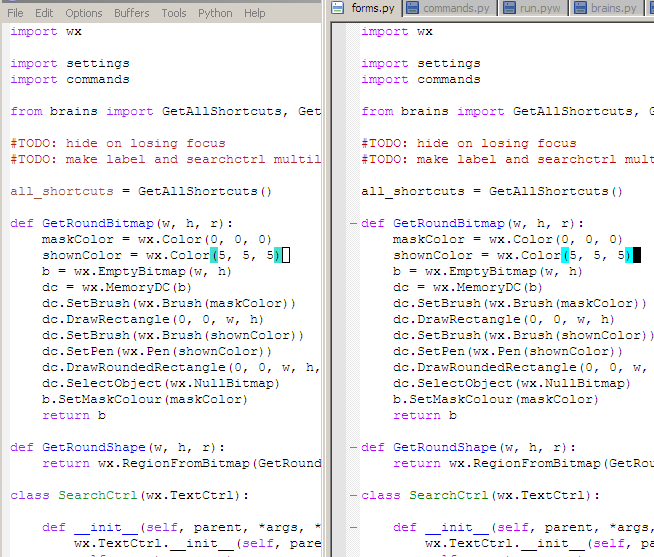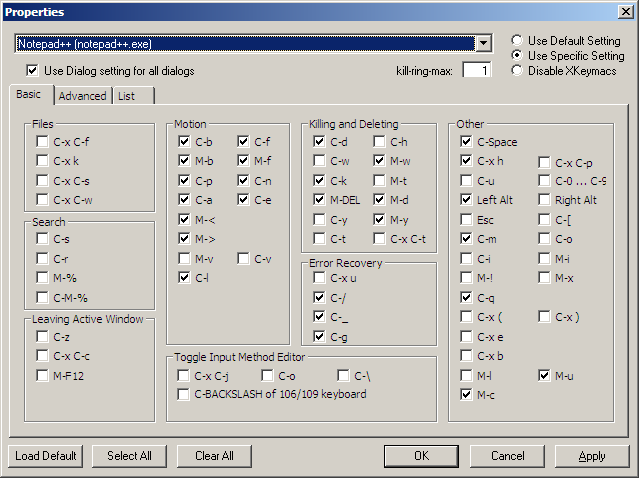Emacs keys in any Windows application
Having finally given up on Emacs in favor of simpler editors, I still could not get rid of its keyboard layout (keyboard combinations, chords, shortcuts, keybindings). I note that the two reasons that kept me on Emacs were:
I found a substitute for both. First, a small lyrical digression - the thing is that along with thematuring rotation of the counter of past years comes an increasing desire to KISS . This, in particular, was expressed for me by the fact that when the Emacs feature, which interfered with live features showed up (dns-lookup, which he performed for a local host when performing many file operations, frisil it for 10 seconds in certain network configurations, for example, I have work), I heed the same advice to use a text editor instead of Emacs. For large projects - IDE (Eclipse, VS, etc), for quick editing of individual files and small projects in Python - Notepad ++.
Replacing the Org-Mode was easy - after buying an Android smartphone, I already almost completely switched to Google Tasks paired with the GTasks app. The functionality turned out to be quite enough (due to my inclination towards KISS, again, I refused to complete GTD options and time planning, hierarchical lists and maintaining advanced statuses for projects / tasks), and to use it is even more convenient than Org-Mode (in terms of synchronization and simplicity of work)
')
To solve the second moment I had to google 15 minutes. As a result, two solutions were found that allow you to use Emacs keyboard shortcuts in any Windows application:
PS And in Emacs I really liked the color scheme for Python, did the same in Notepad ++:

- Org-Mode , the motto of this project, “Your Life in Plain Text” quite accurately reflects its essence. It is powerful and convenient (although not in all respects) functional both for maintaining the usual list of TODO-records, and for more complex cases (GTD, scheduler, organizing directories of something, etc.)
- Key bindings , Emacs keyboard shortcuts. What it seemed so difficult to get used to, moving through the text with Ctrl + F, B, N, P, E, A scrolling through the pages Ctrl + V, Alt + V and other combinations that allow you to keep your hands on the alphanumeric part keyboard while typing and navigating through the text firmly ate after already quite short use of Emacs.
I found a substitute for both. First, a small lyrical digression - the thing is that along with the
Replacing the Org-Mode was easy - after buying an Android smartphone, I already almost completely switched to Google Tasks paired with the GTasks app. The functionality turned out to be quite enough (due to my inclination towards KISS, again, I refused to complete GTD options and time planning, hierarchical lists and maintaining advanced statuses for projects / tasks), and to use it is even more convenient than Org-Mode (in terms of synchronization and simplicity of work)
')
To solve the second moment I had to google 15 minutes. As a result, two solutions were found that allow you to use Emacs keyboard shortcuts in any Windows application:
- Autohotkey script EmacsEverywhere , in the pros - the simplicity and the ability to quickly finish for themselves. In the minuses - a small number of supported shortcuts.
- The utility (for Windows) XKeymacs , the possibilities are wider, supports a bunch of keyboard shortcuts (including text selection (region) using Ctrl + Space and cursor movement keys, which is why I use this option for now), it is possible to disable certain combinations individual for different applications:

Moreover, you can set up a default profile in which there will be only Ctrl + F, B, N, P and use these arrow keys to move instead of arrows in any Windows application, in Total Commander, for example.
I have XP, so I’m not sure if this application will work as well on older versions of Windows, but so far no bugs have been noticed, except that some shortcuts work somehow strangely - for example, using Ctrl + X, Ctrl + S in Notepad ++ flashes the “File” menu every time, as if you cannot save a file without emulating the menu item. But for me the main thing was still exactly the movement of the cursor and work with the buffer - and these parts work without wrangling.
PS And in Emacs I really liked the color scheme for Python, did the same in Notepad ++:

Source: https://habr.com/ru/post/129983/
All Articles